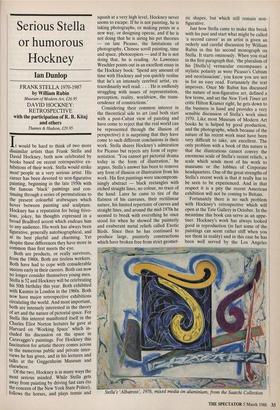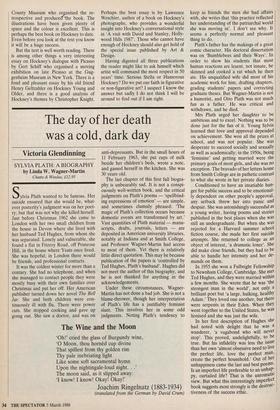Serious Stella or humorous Hockney
Ian Dunlop
FRANK STELLA 1970-1987 by William Rubin
Museum of Modern Art, £26.95
DAVID HOCKNEY: RETROSPECTIVE with the participation of R. B. Kitaj and others
Thames & Hudson, £29.95
It would be hard to think of two more dissimilar artists than Frank Stella and David Hockney, both now celebrated by books based on recent retrospective ex- hibitions of their work. Stella would strike most 'people as a very serious artist. His career has been devoted to non-figurative painting, beginning in the late 1950s with the famous 'black' paintings and con- tinuing through a series of permutations to the present colourful arabesques which hover between painting and sculpture. Hockney has a reputation for being frivo- lous, jokey, his thoughts expressed in a broad Bradford accent which endears him to any audience. His work has always been figurative, generally autobiographical, and at its best playful and charming. Yet despite these differences they have more in common than first meets the eye.
Both are products, or really survivors, from the 1960s. Both are tireless workers. Both have had to cope with considerable success early in their careers. Both can now no longer consider themselves young men. Stella is 52 and Hockney will be celebrating his 50th birthday this year. Both exhibited with Kasmin in London in the 1960s. Both now have major retrospective exhibitions circulating the world. And most important, both are intensely interested in the theory of art and the nature of pictorial space. For Stella this interest manifested itself in the Charles Eliot Norton lectures he gave at Harvard on 'Working Space' which in- chided his discussion on the space in Caravaggio's paintings. For Hockney this fascination for artistic theory comes across in the numerous public and private inter- views he has given, and in his lectures and talks at the Guggenheim Museum and elsewhere.
Of the two, Hockney is in many ways the most serious minded. While Stella gets away from painting by driving fast cars (to the concern of the New York State Police), follows the horses, and plays tennis and squash at a very high level, Hockney never seems to escape. If he is not painting, he is taking photographs, or making prints in a new way, or designing operas, and if he is not doing that he is airing his pet theories — on late Picasso, the limitations of photography, Chinese scroll painting, time and space, photocopiers — and if he is not doing that, he is reading. As Lawrence Weschler points out in an excellent essay in the Hockney book: 'Spend any amount of time with Hockney and you quickly realise that he's an intensely cerebral artist, ex- traordinarily well read. . . . He is endlessly struggling with issues of representation, perception, reality, worldview, the trans- cendence of constrictions.'
Considering their common interest in the theoretical side to art (and both start with a post-Cubist view of painting and have come to reject that the real world can be represented through the illusion of perspective) it is surprising that they have come to such different conclusions in their work. Stella shares Hockney's admiration for Picasso but rejects any form of repre- sentation. 'You cannot get pictorial drama today in the form of illustration,' he argues. Stella's answer has been to remove any form of illusion or illustration from his work. His first paintings were uncomprom- isingly abstract — black rectangles with etched straight lines, no colour, no trace of the hand. Later he came to tire of the flatness of his canvases, their rectilinear nature, his limited repertoire of curves and straight lines, and around the mid-1970s he seemed to break with everything he once stood for when he showed the painterly and exuberant metal reliefs called Exotic Birds. Since then he has continued to produce large, painterly constructions which have broken free from strict geomet- ric shapes, but which still remain non- figurative.
Just how Stella came to make this break with his past and start what might be called 'a second career' as an artist is given an orderly and careful discussion by William Rubin in this his second monograph on Stella. It starts ominously. When you read in the first paragraph that, 'the pluralism of his [Stella's] vernacular encompasses a stylistic polarity as were Picasso's Cubism and neoclassicism', you know you are not in for an easy read. Fortunately the text improves. Once Mr Rubin has discussed the nature of non-figurative art, defined a few terms, and set the New York Times art critic Hilton Kramer right, he gets down to the business in hand and provides a very sensible discussion of Stella's work since 1970. Like most Museum of Modern Art books he is helped by good production, and the photographs, which because of the nature of his recent work must have been very difficult to take, are excellent. The only problem with a book of this nature is that the illustrations cannot convey the enormous scale of Stella's recent reliefs, a scale which sends most of his work to museums or the lobbies of Corporate headquarters. One of the great strengths of Stella's recent work is that it really has to be seen to be experienced. And in that respect it is a pity the recent American exhibition will not be coming to Britain.
Fortunately there is no such problem with Hockney's retrospective which will open at the Tate Gallery in October. In the meantime this book can serve as an appe- tiser. Hockney's work has always looked good in reproduction (in fact some of the paintings can seem rather stiff when you see them in reality) and in this case he has been well served by the Los Angeles Stella's 'Albatross', 1976, mixed media on aluminium, from the Saatchi Collection County Museum who organised the re- trospective and produce the book. The illustrations have been given plenty of space and the colour is excellent. This is perhaps the best book on Hockney to date. Even before you look at the text you know it will be a huge success.
But the text is well worth reading. There is among other things a very interesting essay on Hockney's dialogue with Picasso by Gert Schiff who organised a moving exhibition on late Picasso at the Gug- genheim Museum in New York. There is a fond and pleasant essay by his old friend Henry Geltzahler on Hockney Young and Older, and there is a good analysis of Hockney's themes by Christopher Knight. Perhaps the best essay is by Lawrence Weschler, author of a book on Hockney's photographs, who provides a wonderful insight into Hockney's conversational style in 'A visit with David and Stanley, Holly- wood Hills 1987'. Those who cannot have enough of Hockney should also get hold of the special issue published by Art & Design.
Having digested all three publications the reader might like to ask himself which artist will command the most respect in 50 years' time. Serious Stella or Humorous Hockney? Do we put our faith in figurative or non-figurative art? I suspect I know the answer but sadly I do not think I will be around to find out if I am right.



















































 Previous page
Previous page